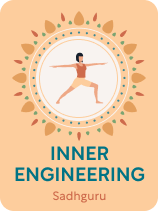

This article is an excerpt from the Shortform book guide to "Inner Engineering" by Sadhguru. Shortform has the world's best summaries and analyses of books you should be reading.
Like this article? Sign up for a free trial here.
What are the four parts of the mind in yoga philosophy? How does the human mind become imbalanced?
In yogic philosophy, there are four aspects of the mind: intellect, memory, identity, and awareness. According to yogi Sadhguru, most problems humans experience are the result of a disbalance between these four aspects whereby memory, identity, and intellect override awareness.
Keep reading to learn about the concept of the yogic mind, according to Sadhguru.
The Mind
In yogic philosophy, the mind is categorized into four parts: intellect, memory, identity, and awareness. A major problem we face is the imbalance of these four aspects of the mind because we tend to filter everything through our intellect, memory, and identities while neglecting our awareness. The four aspects of the yogic mind work are as follows:
- Intellect: This is the thinking mind that’s concerned with survival and tends to divide and categorize things in order to understand the world. The intellect judges everything based on sensory input and what it has stored.
- Memory: This is the part of the mind that stores the judgments you’ve accumulated over time. It can keep us trapped in the past as well as distort new information based on the impressions that are stored there.
- Identity: This part of our mind includes the impressions of ourselves that we accumulate over time. Identity distinguishes us from others, and therefore divides and limits us.
- Awareness: This is the pure consciousness aspect of your mind that is engaged when we practice mindfulness.
Sadhguru explains that awareness (called chitta in yogic terminology) is a way of knowing that is not influenced by our memories and identities. It allows us to discriminate what’s actually true from what our mind is saying based on its distorted perceptions and social conditioning. Our task in yoga is to develop our awareness, in order to move beyond our boundaries and enhance our experience of life.
Sadhguru also argues that awareness exists on a continuum. When we’re asleep we’re in our most limited state of awareness. When we’re awake, we’re in a mid-range state of awareness. When we’re enlightened, we’re in a state of full awareness. So, he says, our everyday consciousness is a reduced state of awareness—and we’re not even cognizant of it. Just like when we’re sleeping, we’re not cognizant of the fact that we’re asleep; we only realize it by comparison when we wake up. The same happens with enlightenment.
| Purusha and Prakriti The Bhagavad Gita, one of the most important texts in Hindu literature, reveals spiritual truths through the story of the Hindu god Krishna. In this text, Krishna emphasizes the importance of recognizing what’s real and what’s not. And he says that anything that’s temporary is not real, including those aspects of yourself that are formed by your experiences in the material world. In this philosophy, pure awareness or the true self is called purusha—the unchanging, eternal essence of an individual that’s distinct from the changing, impermanent aspects of the mind and body. Purusha is often contrasted with prakriti, which refers to the material world of nature and the physical body. The intellect, memory, and identity layers of the mind are therefore prakriti, because they’re all shaped and maintained by our experiences with the outside world, as filtered through our five senses. The goal of spiritual practice is to recognize the true nature of the self as purusha, which is the only aspect of yourself that is, essentially, the real you. Everything else that you think of as you is just a collection of impressions you’ve gathered from your external environment over the course of your life. |
Sadhguru says in yogic terminology, a well-developed human mind is called a kalpavriksha, which translates to “wishing tree.” This means that when our minds are in their optimal state—an enlightened state—whatever we wish for becomes reality because we create our own reality. You don’t need to have faith to manifest this, he says. You just need to have commitment to the process, which involves the following steps:
- Figure out what you really want, with as much clarity as possible.
- Commit to creating it.
- Establish a steady stream of thought in that direction.
The trick, Sadhguru says, is getting that first step right. We may think that’s the easiest step, but it’s actually the most difficult. That’s because, he says, when your mind is in its limited state, you don’t have clarity about what you want. You desire things that don’t really end up making you happy and fulfilled. Many people think they know what they want, but this is muddied by social expectations, judgments about what we’re supposed to want and do, and limiting ideas about what’s possible.
For example, we may spend our lives pursuing wealth, because that’s what we’re conditioned to believe is equated with success. Or we may not pursue our dreams because we believe they’re unrealistic. Sadhguru says the work of inner engineering needs to be undertaken to get your mind to the point where it has a clear vision, unsullied by our conditioned beliefs.
| Who Do You Want to Be? In Think Like a Monk, Jay Shetty argues that we’ve been socially conditioned to pursue what we think others expect from us, and we believe those are the things we want. We may not even realize they are someone else’s goals, and that’s why they may not actually make us any happier. For example, if your parents always encouraged you to play sports, their positive reinforcement around sports in your childhood may make you think that pursuing athletic goals will lead to happiness, although it might not actually be what you want deep down. Like Sadhguru, Shetty points out that it can be difficult to determine what you want apart from your social conditioning. He argues that clearly defining your core values may be more conducive to happiness than defining any specific goals. Instead of figuring out what you want, he advises you to figure out who you want to be and let that guide you. |

———End of Preview———
Like what you just read? Read the rest of the world's best book summary and analysis of Sadhguru's "Inner Engineering" at Shortform.
Here's what you'll find in our full Inner Engineering summary:
- An introduction to the science of yoga and its transformative powers
- Renowned yogi Sadhguru's journey of self-discovery
- Why yoga is not meant to be an exercise or a way to get "fit"






